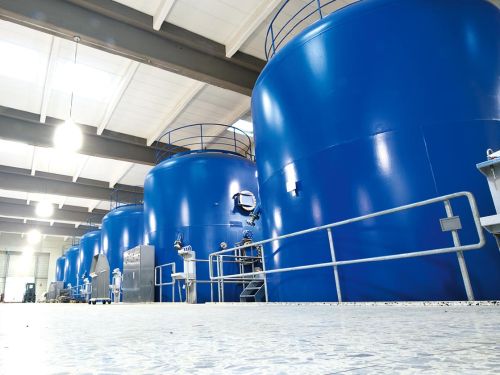Filtering water permanently and more efficiently

New Logic Research relies on vibration and ifm for its VSEP technology
Filtration is the simplest way to separate solids from a liquid. Basically, all you need is a filter – usually a membrane in the industrial sector – and pressure to press the mixture onto the membrane surface. The size of the pores in the membrane determines which solids in the liquid are retained by the membrane. The problem: Over time, these solids foul and plug the pores, thus preventing any liquid from passing. It is then high time to replace the membrane.
Vibration prevents membrane fouling
The founders of New Logic Research also realised that this is sometimes quite an expensive undertaking. With Vibratory Shear Enhanced Processing (VSEP), they offer a filtration technique that, according to the company, significantly increases the service life of the membrane and also allows up to ten times higher filtration rates.
Chip Johnson, COO of New Logic Research, explains: “As the name suggests, we use vibration, which is specifically applied to the membrane, during the filtration process. This helps to keep the membrane surface cleaner and ensures the cycles between cleaning or replacing a membrane are significantly longer than those of competing filtration techniques. At the same time, we achieve an extremely high level of throughput with less power consumption.”
All relevant values of the system at a glance
To ensure the filtration process runs as efficiently as possible, New Logic Research today relies on numerous ifm sensors to permanently monitor the parameters vibration, flow rate, pressure, temperature and the conductivity of the water as indicators of the filtration quality. “In the beginning, we supplied filtration systems without comprehensive sensor technology to our customers, who were then responsible for their operation. However, we soon realised that our system can only achieve the desired and expected efficiency and longevity if it is handled correctly, and that correct handling is intrinsically linked to specific know-how that we cannot always expect customers to have. That’s why we decided to offer filtration as a service,” says Chip Johnson.



Picture 1: Heart of the overall system: The filtration system together with the 20 hp motor that generates the vibratory action at the membrane.
Picture 2: More clarity in the control cabinet: Thanks to IO-Link, the number of incoming cables is reduced considerably.
Picture 3: The standard M12 connection ensures error-free wiring.
Automation creates maximum efficiency
Since changing the corporate approach, relevant values are now monitored by sensors – which provides a range of benefits for both customers and New Logic Research: “Thanks to full-scale automation and continuous monitoring of the filtration system, we’re always able to get a clear picture of a system’s condition for ourselves and our customers. This is how we prevent the expensive membranes from being excessively stressed. In most cases, we can perform the regular system checks remotely – saving us and our customers a lot of time and money, as our experts only have to be on site in case of an emergency,” says Johnson.

The IO-Link masters receive the data from the sensors in a decentralised manner and forward it as a bundled package. This reduces cable routes, saves time and eliminates sources of error.
Reliable sensor makes a lasting impression
The fact that New Logic Research relies primarily on ifm for monitoring and controlling its filtration systems has to do with Johnson’s initial experience with a pressure sensor from the automation specialist: “I don’t remember exactly when I first came into contact with ifm,” says Johnson. “What I do remember very clearly though is that the first pressure sensor I bought from ifm was simply indestructible. It ran and ran and ran – I wouldn’t be surprised if it’s still busy at work in some system somewhere. This level of reliability, this excellent price-performance ratio, quickly convinced all of us at New Logic Research. And because ifm offers a wide range of sensors that we can actually use, the company is our first choice in these cases.”
IO-Link infrastructure speeds up cabling
In addition to the sensor technology, New Logic Research also relies on ifm’s IO-Link portfolio.
Engineering Manager Matt Ayers describes the advantages of the system: “Thanks to the IO-Link masters and standard M12 cabling, we’ve been able to speed up the wiring of our filtration systems considerably. Instead of having to label hundreds of metres of cables, pulling them through the system to the central controller and making sure they’re all connected correctly, we can now connect the sensors to the masters in a decentralised manner. And thanks to the standard M12 connection, this is achieved without errors and without having to constantly think about what you’re doing. What took us a few weeks in the past, can now be implemented in just a few days. This provides a considerable time buffer, especially in the high-pressure phase shortly before delivery to our customers.”
Separating the precious from the valuable
Customers who rely on New Logic Research’s filtration systems include, for example, mine operators and manufacturers of catalytic converters for the automotive market. “The reasons why our customers turn to our systems are the same, no matter what industry they’re from. They want to separate water from valuable solids as efficiently as possible in order to use them either for the first time or again. Other customers use our systems to treat their industrial process water before returning it to the regular cycle. The more efficiently our customers achieve their goals, the more attractive our filtration method becomes. And the more water of sufficient quality is returned to the global cycle. So, in many cases we separate the precious from the valuable. As water is set to become the new oil; and the only thing that can be done today and in the future is to conserve as much of this increasingly rare resource as possible. And we want to contribute to this with our solutions.”
Conclusion
With the help of ifm’s reliable sensors, New Logic Research can offer its customers a holistic service consisting of efficient filtration and condition monitoring. And IO-Link takes efficiency to the next level by enabling automation. Thanks to fast, guaranteed error-free cabling.



